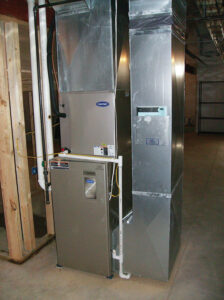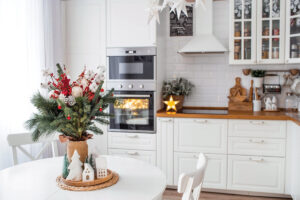 Sometime in your life you will need to buy a new furnace. Either you are building a new home, the old furnace finally gave up, or you are being proactive and would like to invest in something more energy efficient. Whatever your reason, it is very important to install a properly sized furnace to match the btu/hr heat loss of your home at the outdoor winter design temperature for your location. Here in Peoria it’s about -2° below zero.
Sometime in your life you will need to buy a new furnace. Either you are building a new home, the old furnace finally gave up, or you are being proactive and would like to invest in something more energy efficient. Whatever your reason, it is very important to install a properly sized furnace to match the btu/hr heat loss of your home at the outdoor winter design temperature for your location. Here in Peoria it’s about -2° below zero.
In past articles I have mentioned that your first energy efficiency priority is to have a good building shell, because the heating and cooling systems are sized to the house. This is where having a good building shell pays off big time. Your HVAC contractor should do a “Manual J” heat loss calculation to determine the Btu heat loss of your home. Once they know the heat loss, they can properly size the furnace. It makes sense. To do this they will need to get the square footage and R-value of the insulation in the attic, exterior walls, and basement walls, measure the windows, etc. They then enter the data into a software program that can calculate heat loss. I can tell you this is not just a 10-15 minute walk-thru of the house.
Most people think that bigger is better and that couldn’t be further from the truth. Let’s think about this. If you had an oversized furnace it would fire up and run for a few minutes and turn off. Fire up again and run for a few minutes and turn off. All of the homes I go to with oversized furnaces have hot or cold rooms or floors, humidity problems and significant comfort issues.
What happens when a furnace fires up? First the flame heats up the heat exchanger in the furnace to a predetermined temperature. Then the main blower turns on and pulls air from the house to circulate it through the furnace and flows throughout the house through the ducts.
Let’s look at the combustion efficiency of your furnace. I have measured the combustion efficiency of hundreds of furnaces. The flame in your furnace has to operate for a minimum of 5 minutes to reach its rated efficiency. The 95% efficient furnaces and higher need to run even longer to reach their maximum combustion efficiency. This is no different than your car. Imagine the gas mileage you would get if you were to run your car until it almost reached the operating temperature and then shut it off, let it cool down and did it all over again all day long. That would drastically reduce your fuel mileage, right? This is exactly what happens with an oversized furnace. While the combustion efficiency is low during warm-up, the furnace is putting out less Btu’s for the amount of gas used compared to when it is up to operating temperatures.
Now let’s look at how an oversized furnace can affect the comfort level of your home. Ducts carry the warm or cool air to and from the house. On a cold winter day do you think the ducts are somehow staying nice and warm while your furnace is off? Nope. They have cooled to room temperature during the off cycle. When the furnace turns on, the cool ducts have to heat up to about 120° or so before any heat will come out of them.

If you have a large ranch or a two story home with long duct runs to remote rooms, it takes more time to heat up those long runs than shorter runs. I have seen times where the short-cycling furnace turns off before any heat comes out of the duct in the room. This may be a reason why some of the rooms in your home may be cooler than others. If the furnace was sized correctly, so you had nice long run times of about 20 minutes, all of the ducts could warm up and actually put heat into all the rooms. The home would feel more comfortable, heat more evenly, and the furnace would operate at peak efficiency. The 2012 Energy Code requires that a furnace cannot be oversized more than 15 percent and 10 percent for air conditioning.
Oversized furnaces are very common. I have never come across a furnace that was too small for the home, ever!








